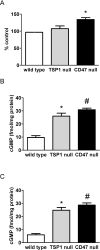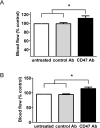Age-associated induction of cell membrane CD47 limits basal and temperature-induced changes in cutaneous blood flow
- PMID: 23275312
- PMCID: PMC3626753
- DOI: 10.1097/SLA.0b013e31827e52e1
Age-associated induction of cell membrane CD47 limits basal and temperature-induced changes in cutaneous blood flow
Abstract
Objective: We tested the hypothesis that the matricellular protein thrombospondin-1 (TSP1), through binding to and activation of the cell receptor CD47, inhibits basal and thermal-mediated cutaneous blood flow.
Background: Abnormal and decreased cutaneous blood flow in response to temperature changes or vasoactive agents is a feature of cardiovascular disease and aging. The reasons for decreased cutaneous blood flow remain incompletely understood. Furthermore, a role for matricellular proteins in the regulation skin blood flow has never been proposed.
Methods: C57BL/6 wild type, TSP1-null, and CD47-null 12- and 72-week-old male mice underwent analysis of skin blood flow (SkBF) via laser Doppler in response to thermal stress and vasoactive challenge.
Results: Young and aged TSP1- and CD47-null mice displayed enhanced basal and thermal sensitive SkBF changes compared with age-matched wild type controls. Nitric oxide-mediated increases in SkBF were also greater in null mice. TSP1 and CD47 were expressed in skin from young wild type mice, and both were significantly upregulated in aged animals. Tissue 3',5'-cyclic guanosine monophosphate, a potent vasodilator, was greater in skin samples from null mice compared with wild type regardless of age. Finally, treating wild type animals with a CD47 monoclonal antibody that inhibits TSP1 activation of CD47 enhanced SkBF in both young and aged animals.
Conclusions: These results suggest that secreted TSP1, via its cognate receptor CD47, acutely modulates SkBF. These data further support therapeutically targeting CD47 to mitigate age-associated loss of SkBF and maximize wound healing.
Figures





References
-
- Charkoudian N. Skin blood flow in adult human thermoregulation: how it works, when it does not, and why. Mayo Clin Proc. 2003;78:603–612. - PubMed
-
- Wallin BG. Neural control of human skin blood flow. J Auton Nerv Syst. 1990;30(Suppl):S185–190. - PubMed
-
- Charkoudian N, Johnson JM. Female reproductive hormones and thermoregulatory control of skin blood flow. Exerc Sport Sci Rev. 2000;28:108–112. - PubMed
-
- Heistad DD, Abboud FM. Factors that influence blood flow in skeletal muscle and skin. Anesthesiology. 1974;41:139–156. - PubMed
-
- Belcaro G, Vasdekis S, Rulo A, Nicolaides AN. Evaluation of skin blood flow and venoarteriolar response in patients with diabetes and peripheral vascular disease by laser Doppler flowmetry. Angiology. 1989;40:953–957. - PubMed
Publication types
MeSH terms
Substances
Grants and funding
LinkOut - more resources
Full Text Sources
Other Literature Sources
Research Materials
Miscellaneous

